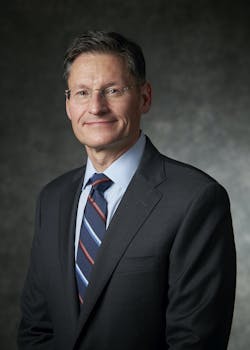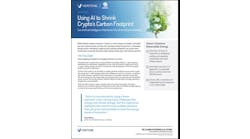Energy as a service (EaaS) agreements allow energy customers to transfer the risks associated with owning energy assets, and focus on their core mission. It is also an attractive option for businesses with capital constraints. Louis Maltezos, executive vice president at Ameresco, discusses this route with Microgrid Knowledge.
What is energy as a service (EaaS), and how does it differ to an energy performance contract?
Louis Maltezos: EaaS is an offering where energy related infrastructure improvements or technologies are delivered to an end customer, under a long-term service agreement, with no capital provided by that customer. The service provider assumes the risk of ownership related to the equipment, and the requirements of the contract are usually specified as outcomes or key performance indicators. Payment to the EaaS provider is contingent on achievement of the set outcomes.
Under an energy performance contract, there are typically two contracts going on; one with the energy performance contractor for implementation of the project and guarantee of energy savings, plus a separate contract for financing that is typically with a third party. Under an EaaS, on the other hand, there is only one contract: the EaaS service agreement between the customer and the ESCO. This makes EaaS particularly attractive for customers that are capital constrained, as debt can be kept off the balance sheet. EaaS is also suitable if you want to focus on core business and let someone else invest in, operate and maintain your energy systems. Ownership risk is shifted to the EaaS provider, and payment is based on performance. This is an added incentive for the EaaS provider to use the best technology.
The COVID-19 situation appears to be causing customers to re-think their interest in investing in long-term energy assets. Anecdotally, I have seen an increased interest in EaaS over the last six to nine months. Customers are attracted to the idea of locking in an energy cost, paying for improvements out of savings, and transferring the risk of energy operations.
What is the difference between funding and financing for EaaS projects?
LM: Financing refers to how the capital is sourced to make the required investment under the EaaS program, financing is the responsibility of the EaaS provider. It could be debt, equity or a combination. In Ameresco’s case, we have the flexibility to provide the capital ourselves, or work with capital partners, depending on what makes the most sense in a given situation. Funding, on the other hand, refers to how the customer is actually going to come up with the dollars to pay the service fee under the EaaS contract. Depending on the circumstances, there can be a number of options. Our focus is working with customers to generate as much saving from the utility and operating budgets as possible to fund the payments. In this way, our EaaS projects are typically structured to be budget neutral or cashflow positive to the customer.
What steps are taken to set up an EaaS agreement for a customer?
LM: There are three general steps, with the details varying depending on the level of complexity of the customer and the site. The first step is to define the customer’s goals. Do they have aging infrastructure and deferred maintenance needs to address? Do they have systems that are not yet commissioned, or not operating properly? Are they concerned about reliability, or have environmental goals? Once all the goals are identified, the second step is to evaluate the existing systems and infrastructure to ascertain gaps and opportunities for the EaaS provider to make investments or changes to the operation and maintenance strategies to address the needs and achieve the goals.
Once this is complete, the third step is to codify the goals in terms of key performance indicators in a service level agreement that can be used as the basis for assessing the EaaS provider’s performance under the contract.
How long are EaaS agreements, and how do they remain competitive over time?
LM: In my experience, the range is between seven and 30 years, but it’s important to understand that EaaS is a flexible model and can be customized to the circumstances. Generally, if deeper and broader interventions need to be made by the EaaS provider, the term is longer to allow investment to be made and recuperated over time. If the project is simple, such as a lighting retrofit, the EaaS agreement can be shorter.
The built-in key performance indicators and service level agreement provide the competitiveness for the customer. We tend to have a frank discussion with the customer about which criteria are important for them and include them in the contract. The payments are contingent on the EaaS provider delivering the defined service. If they are not delivered, the customer doesn’t pay.
Are there any notable Ameresco projects using the EaaS model?
LM: The model was used at the US Marine Corps Recruit Depot Parris Island, this is where every new Marine Corps recruit East of the Mississippi river goes for training. It’s a mission critical facility, so energy resilience, reliability, and security are very important. The scope of work for that project included 21 energy conservation measures, a 3.5 MW CHP plant with 3.6 MW of redundant diesel backup, 6.7 MW of solar PV, and a 4 MW/ 8 MWh battery energy storage system. Tied together with a microgrid control system, the control system is capable of fast load shed in response to system contingencies, and coordinates dispatch of conventional, renewable, and storage assets to allow the site to maintain efficient, cost effective, and reliable operations. In the event of loss of service from the utility, or in advance of events such as tropical storms and hurricanes, the Depot can “island” from the utility to self-supply its energy needs. Ameresco sourced all the capital for the project, the customer did not have to make any payments until the system was up and running and achieving the agreed key performance indicators. The payments are funded from the energy savings resulting from the project.
At the other end of the spectrum, we have a project with the London District Catholic School Board at their John Paul II secondary school in Ontario, Canada. We are installing around 800 kW of solar PV, a 2 MWh battery storage system, and a large geothermal heating and cooling system. Again, this is tied together with a microgrid controller, which will allow the school to isolate from the utility during outages. Ameresco will own and operate the assets and the school will buy the output from Ameresco over the course of the service agreement.
Both projects have similar building blocks and similar benefits, but at a different scale and different primary drivers. For the Marine Corps, it’s about resiliency, whereas the school’s main driver was carbon neutrality.
Louis Maltezos is an executive vice president at Ameresco.







